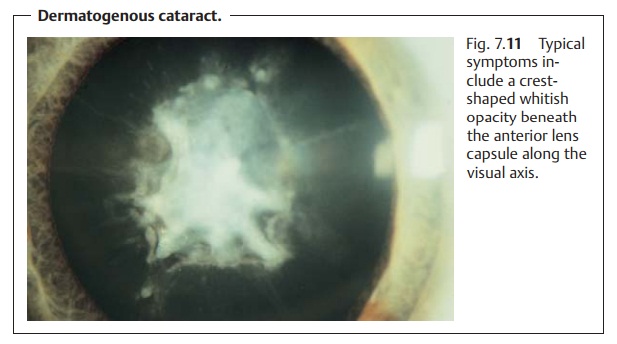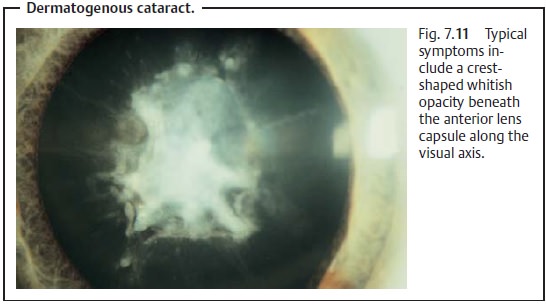Chapter: Ophthalmology: Eye Lens
Cataract in Systemic Disease

Cataract in Systemic Disease
Epidemiology.
Lens opacities can occasionally occur as a sign of systemic
dis-ease.
Forms of cataracts in systemic disease:
Diabetic cataract.The typical diabetic cataract is rare in young diabeticpatients.
Transient metabolic decompensation promotes the occurrence of a typical radial
snowflake pattern of cortical opacities (snowflake cataract). Transient hyperopia
and myopia can occur.
Diabetic cataract progresses rapidly. Senile
cataracts are observed about five times as often in older diabetics as in
patients the same age with normal metabolism. These cataracts usually also
occur two to three years earlier.
Galactosemic cataract.Thisdeep posterior
cortical opacitybegins after birth.Galactosemia is a rare cause of early
cataract in children lacking an enzyme required to metabolize galactose. The
newborn receives ample amounts of galactose in the mother’s milk. Due a lack of
uridyl transferase, or less frequently galactokinase, galactose cannot be
metabolized to glucose, and the body becomes inundated with galactose or with
galactose and galactose-1-phosphate. If the disorder is diagnosed promptly and
the child is maintained on a galactose-free diet, the opacities of the first
few weeks of life will be reversible.
Galactosemic cataract is the only form of
cataract that responds to con-servative therapy.
Dialysis cataract.Hemodialysis to eliminate metabolic acidosis in
renalinsufficiency can disturb the osmotic equilibrium of lens metabolism and
cause swelling of the cortex of the lens.
Other rare
metabolic diseases that can cause cataract include mannosido-sis, Fabry’s
disease, Lowe’s syndrome (oculocerebrorenal syndrome), and Wilson’s disease
(hepatolenticular degeneration).
Cataract with myotonic dystrophy.Opacities first occur between the ages of30 and 50, initially in
a thin layer of the anterior cortex and later also in the
subcapsular posterior cortex in the form of
rosettes. Detecting these opacities is important for differential diagnosis as cataracts do not occur in Thomsen’s
disease (myotonia congenita) or Erb’s progressive muscular dystrophy.
Symptoms that confirm the diagnosis include cataract, active signs of myo-tonia
(delayed opening of the fist), and passive signs of myotonia (decreased
relaxation of muscles in the extremities following direct percussion of the
muscle and absence of reflexes).
Tetany cataract.The opacity lies within a broad zone inferior to the
anteriorlens capsule and consists of a series of gray punctate lesions.
Symptoms that confirm the diagnosis include
low blood calcium levels, a positive hyperventi-lation test, and signs of
tetany: positive Chvostek, Trousseau, and Erb signs.

Dermatogenous cataract.This may occur with chronic neurodermatitis, lessfrequently with
other skin disorders such as scleroderma, poikiloderma, and chromic eczema.
Characteristic signs include an anterior crest-shaped thickening of the
protruding center of the capsule (Fig. 7.11).
Related Topics